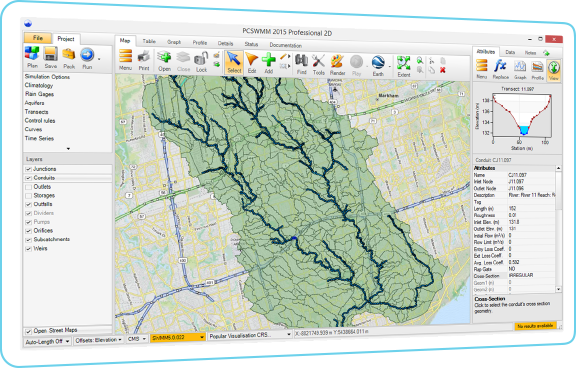

SWMM5 and XPSWMM and share the same technique to simulate adverse slopes (reversal of link upstream and downstream nodes) and the switch to the Normal flow equation for steep links. All three models limit the number of iterations and use similar methods for link convergence. SWMM5 uses a variable time step but does not employ time step halving.

ICM and XPSWMM both use a variable time step with time step halving for non-convergence at each time step of the simulation. SWMM5, ICM and XPSWMM all phase out St Venant terms as the Froude number increases from 0.5 to 1 and uses drop out non-linear terms when the Froude Number is above 1. ICM calculates the headloss at a node and is not a link/node solution but a 4 point implicit link solution with at least 5 computational points in a link. SWMM5 and XPSWMM use a link/node solution in which the area and depth of a node are calculated from the Storage Equation and the Surface Area of the node and associated links in the node. ICM and SWMM5 share the same solution (SWMM FM) for Force Mains.

The Pressure and Force Main solutions do not use a Preissmann Slot. ICM has three conduit models: Conduit, Pressure and Force Main. ICM and XPSWMM use a Preissmann Slot for surcharged conduit flows. Related issues cause the need for a hot start file in SWMM5 and XPSWMM. This same issue affects the procedure in which ICM initializes the network before commencing the network simulation. SWMM5 and XPSWMM can simulate truly dry links and nodes. ICM links never dry out as there is a small base flow or base depth in all links. However, there are key differences in how the numerical engines compute the flows, depths and associated hydraulic parameters in links and nodes. All these 1D solutions share the need for modeling and simulating the smooth transition between dry flow, partial flow, pressure flow and flooding flow. They all have linear link, connecting node and polygon area driven simulation engines so they all look similar in the network view. The Stormwater and Sewer models SWMM5 (InfoSWMM and PCSWMM use the SWMM5 engine), InfoWorks ICM and XPSWMM (which uses a modified SWMM4 engine) share the commonality of solving the 1D St Venant Solution for a large range of link open and closed conduit shapes.


 0 kommentar(er)
0 kommentar(er)
